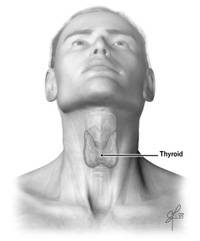Blog
All About the Thyroid


Jill wants to know, “what’s a thyroid and what does it do?” We take care of a lot of problems in family medicine practices. For those like Jill who don’t know what the thyroid gland is or does, read on!
The thyroid is an endocrine gland found in the front part of the neck below and to the sides of the larynx or Adam’s apple. Endocrine glands make hormones that are secreted into the bloodstream and travel around the body where they interact with cells in different tissues signaling them to perform particular functions.
The primary job of the thyroid gland is to control metabolism (energy use) in our cells. It does this by producing two hormones, T4 (thyroxine) and T3 (triiodothyronin). Both of these hormones contain iodine which is why iodine is so important in our diets.
Our cells have hormone receptors protruding from their cell membranes that act as sensors to constantly monitor body functions and tweak them to maintain “homeostasis,” a balanced internal environment. Biochemical systems that maintain homeostasis are extremely elegant. Some work like a furnace thermostat that turns the furnace on or off based on the temperature in the room. Instead of using wires and electricity to communicate, the body uses the circulatory system and hormones as chemical messengers.
The hypothalamus, found near the bottom of the brain, serves as the thermostat in our body that interacts with the thyroid. When the hypothalamus detects the body is cold or requires more energy production, it will release the hormone TRH (Thyrotropin Releasing Hormone). This hormone travels to the pituitary gland, another endocrine gland just below the hypothalamus, where it stimulates the pituitary to secrete TSH (Thyroid Stimulating Hormone) into the bloodstream. The TSH then stimulates the thyroid gland to release T4 and T3.
Once the hypothalamus turns on the thyroid “furnace” via TRH and TSH, how does the system get shut off? The hypothalamus and pituitary also monitor the levels of T4 and T3 in the bloodstream via a feedback loop; when the hormones reach a certain level in the blood they suppress the production of TRH and TSH.
Now that you know the physiology of the thyroid, hopefully it will make it easier to understand how things can go haywire. There are two main problems that can develop with the thyroid. The first is HYPOthyroidism, a “low” thyroid state where too little T3 and T4 are produced. The other is HYPERthyroidism a “high” thyroid state where too much hormone is released. Either one of these conditions can be very serious since homeostasis is knocked out of balance.
Hypothyroidism can result when there is an interruption in any step of the complex hypothalamic – pituitary – thyroid pathway. The hypothalamus may not detect the body is cold or in need of energy and/or may not produce or release TRH to stimulate the pituitary to secrete TSH. The pituitary may not respond to TRH or may not make or release TSH. Finally, the thyroid gland itself may not respond to TSH or make T3 or T4.
Common symptoms of hypothyroidism include fatigue, weight gain, water retention, intolerance to cold, brittle hair and nails, dry skin, muscle cramps, joint aches, thyroid enlargement (goiter), low heart rate and constipation.
Hypothyroidism may result from a number of conditions involving the endocrine glands controlling the thyroid as well as the thyroid’s ability to make T3 & T4. The most sensitive way to diagnose hypothyroidism is by checking the level of TSH in the blood. Levels will be high in the blood because the pituitary is sensing the low levels of thyroid hormone and is trying to stimulate the thyroid to make more T3 and T4. Depending on the situation, blood tests for T3 and T4 may be checked in addition to TSH.
Treatment of hypothyroidism usually involves taking synthetic thyroid hormone pills. Monitoring is performed by checking blood levels of thyroid hormones on a periodic basis and adjusting the replacement medication dose accordingly.
Hyperthyroidism is caused by problems with excess thyroid hormone production. The most common cause, Hashimoto’s thyroiditis, results from a person’s immune system producing antibodies that mimic TSH that keep the thyroid in a constant “on” state. Other problems like thyroid tumors can also cause production of excess hormone.
Symptoms of hyperthyroidism include weight loss, anxiety, tremor, intolerance to heat, rapid heartbeat or palpitations, thyroid enlargement, apathy or depression, and sometimes bulging eyeballs.
Like hypothyroidism, hyperthyroidism is confirmed with lab testing. Usually the level of TSH is low since the pituitary sees plenty of thyroid hormone in the blood. The thyroid hormones T3 & T4 are usually elevated. Additional testing may include ultrasound or nuclear imaging of the thyroid to look for growths or other abnormalities.
The treatment of hyperthyroidism varies based on the cause. It may require taking medication to suppress hormone production or taking radioactive iodine to destroy overactive thyroid tissue. Surgery is sometimes performed. Over-treating hyperthyroidism sometimes results in hypothyroidism with the need to take thyroid hormone pills.
– Dr. John Roberts is a member of the Franciscan Physician Network specializing in Family Medicine.
